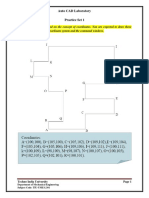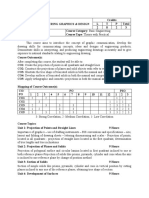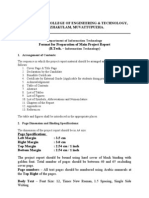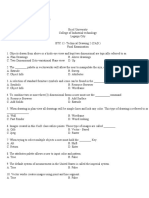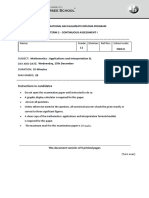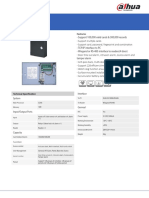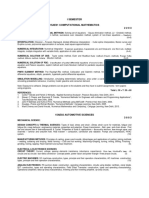Professional Documents
Culture Documents
What Are The Advantages of Autocad Over Manual Drafting
What Are The Advantages of Autocad Over Manual Drafting
Uploaded by
Gaurav BassiOriginal Description:
Original Title
Copyright
Available Formats
Share this document
Did you find this document useful?
Is this content inappropriate?
Report this DocumentCopyright:
Available Formats
What Are The Advantages of Autocad Over Manual Drafting
What Are The Advantages of Autocad Over Manual Drafting
Uploaded by
Gaurav BassiCopyright:
Available Formats
What are the advantages of autocad over manual drafting?
Three Dimensional Modeling: Creating 3D models manually is a very difficult and tiresome job. 3D CAD packages have many more powerful features for creating the 3D models easily. Easy to Modify: Modifying the CAD geometry is easy; you will always have "copy", "cut", "paste", "delete", "move" or some similar editing options available with each of the packages. Easy to Reproduce: Draftsmen used to take days to complete a drawing by manual drafting, and reproducing the drawing meant recreating the drawing from the beginning. But, in case of the CAD, you can reproduce the drawing in no time and make as many copies as you want. Computer Aided Manufacturing (CAM): The 3D CAD geometry is used as input for the CAM packages for generating NC codes. The manual drawings cannot be used for CAM packages. Computer Aided Engineering (CAE): The 3D CAD geometry is used as input for the CAE packages. The CAE packages can simulate the loading conditions and tell whether the CAD geometry can withstand the real loading or not. The drawings created manually cannot be used for CAE. Simulation of the Mechanisms: The 3D CAD geometry can be used for simulating the mechanism, thus you can check the functionality of a machine without investing in prototype building. Manual drawings cannot be used for mechanism simulation. Database Creation: The CAD files can be used to create a PDM/PLM database. Once created, the CAD database can be accessed through a wide area network. The drawings created by manual drafting can only be stored locally. Logical: CAD models or geometry entities are logically connected, or in other words you cannot create a CAD model which is not possible practically. The drawings created by the manual drafting method do not have such checks, and you can create anything. Environment Friendly: Manual drawings are necessarily created on paper, but the CAD drawings can be stored and used electronically without using paper. Access Control: Some of the drawings and design documents are very crucial for a company's business, and such drawings should not be accessible to all. Providing access controls of such drawings are easy for the CAD drawings, and the access level can be defined for each CAD drawings. Strict access control and maintaining confidentiality is difficult for the manual drawings.
CAD
Computer-aided design (CAD), also known as computer-aided design and drafting (CADD), is the use of computer systems to assist in the creation, modification, analysis, or optimization of [2] a design. Computer-aided drafting describes the process of creating a technical drawing with the use of [3] computer software. CAD software is used to increase the productivity of the designer, improve the quality of design, improve communications through documentation, and to create a database for [4] manufacturing. CAD output is often in the form of electronic files for print or machining operations. CAD software uses either vector based graphics to depict the objects of traditional drafting, or may also produce raster graphics showing the overall appearance of designed objects.
[1]
CAD often involves more than just shapes. As in the manual drafting of technical and engineering drawings, the output of CAD must convey information, such as materials, processes, dimensions, and tolerances, according to application-specific conventions. CAD may be used to design curves and figures in two-dimensional (2D) space; or curves, surfaces, and [5] solids in three-dimensional (3D) space. CAD is an important industrial art extensively used in many applications, including automotive, shipbuilding, and aerospace industries, industrial and architectural design, prosthetics, and many more. CAD is also widely used to produce computer animation for special effects in movies, advertising and technical manuals. The modern ubiquity and power of computers means that even perfume bottles and shampoo dispensers are designed using techniques unheard of by engineers of the 1960s. Because of its enormous economic importance, CAD has been a major driving force for research incomputational [6] geometry, computer graphics (both hardware and software), and discrete differential geometry. The design of geometric models for object shapes, in particular, is occasionally called computer-aided [7] geometric design (CAGD). In CAD, many commands are available for drawing basic geometric shapes. Examples include CIRCLE, POLYGON, ARC, ELLIPSE, and more.
You might also like
- Control (If, For, While)Document6 pagesControl (If, For, While)TigereNoch keine Bewertungen
- ME6261-Computer Aided Drafting and Modeling Lab PDFDocument64 pagesME6261-Computer Aided Drafting and Modeling Lab PDFRamesh Jangala100% (1)
- 01: Individual Project: Pearson BTEC HNC Assignment Brief 2020-21Document7 pages01: Individual Project: Pearson BTEC HNC Assignment Brief 2020-21Aouniza Ahmed100% (1)
- AutoCAD IntroductionDocument139 pagesAutoCAD IntroductionEngr Mayer KhanNoch keine Bewertungen
- Chapter 8 Combined LoadingDocument6 pagesChapter 8 Combined LoadingSumaya MahmoodNoch keine Bewertungen
- Eg MCQDocument13 pagesEg MCQpraveen kumarNoch keine Bewertungen
- Integrated Process Simulation and Die-Design in Sheet Metal FormingDocument4 pagesIntegrated Process Simulation and Die-Design in Sheet Metal FormingElaine JohnsonNoch keine Bewertungen
- ME-109 Engineering Drawing: An IntroductionDocument40 pagesME-109 Engineering Drawing: An IntroductionHaadin ZamanNoch keine Bewertungen
- CAD CAM Complete Denture Resins Effect oDocument8 pagesCAD CAM Complete Denture Resins Effect oDoctor JackNoch keine Bewertungen
- Cad Interview QuestionsDocument3 pagesCad Interview QuestionsirfanajaiNoch keine Bewertungen
- Civil EngineeringDocument3 pagesCivil EngineeringRealtor IndiaNoch keine Bewertungen
- 1 s2.0 S0022391310601114 Main PDFDocument9 pages1 s2.0 S0022391310601114 Main PDFPatty ChuNoch keine Bewertungen
- Injection Molding From 3d Printed MoldsDocument22 pagesInjection Molding From 3d Printed MoldsDamien WayneNoch keine Bewertungen
- Database Management System Class 10 Question BankDocument56 pagesDatabase Management System Class 10 Question Banktfpalo4Noch keine Bewertungen
- Cad/Cam: 1. What Are The Six Processes of Conventional Design Process ?Document6 pagesCad/Cam: 1. What Are The Six Processes of Conventional Design Process ?Gowtham Malla100% (1)
- Use of Rapid Prototyping in Rapid ToolingDocument11 pagesUse of Rapid Prototyping in Rapid ToolingSudhanwa KulkarniNoch keine Bewertungen
- Introduction To DBMSDocument18 pagesIntroduction To DBMSprishaamehta05Noch keine Bewertungen
- Consteel Settings Has No Effect On The Export) : 14 User ManualDocument51 pagesConsteel Settings Has No Effect On The Export) : 14 User ManualJuan Unaf VargasNoch keine Bewertungen
- Textbook - Unit 1 - Engineering DesignDocument13 pagesTextbook - Unit 1 - Engineering DesignThuy TranNoch keine Bewertungen
- Types of Construction ProjectsDocument9 pagesTypes of Construction ProjectsAs ReNoch keine Bewertungen
- Department of Collegiate and Technical EducationDocument11 pagesDepartment of Collegiate and Technical EducationHarsha SamagaraNoch keine Bewertungen
- Final Research (Addisu Leta, Structural Eng)Document99 pagesFinal Research (Addisu Leta, Structural Eng)Mohammed B Tuse100% (1)
- Auto CAD Lab Practice Set 1Document4 pagesAuto CAD Lab Practice Set 1Techno India UniversityNoch keine Bewertungen
- RDBMS NotesDocument77 pagesRDBMS NotesRisha A.M100% (1)
- Works Engineer SrilankaDocument4 pagesWorks Engineer Srilankanira365Noch keine Bewertungen
- Mec18r151 Engineering GraphicsDocument2 pagesMec18r151 Engineering GraphicsKKNoch keine Bewertungen
- 300+ TOP ENGINEERING Drawing Multiple Choice Questions & AnswersDocument14 pages300+ TOP ENGINEERING Drawing Multiple Choice Questions & AnswersYogendra KumarNoch keine Bewertungen
- Mini Project Report FormatDocument13 pagesMini Project Report Formatarunmat123100% (1)
- AutoCAD Frequently Asked Interview QuestionsDocument23 pagesAutoCAD Frequently Asked Interview Questionskishore.pd3d94% (34)
- Write A Literature Review With Citation On Construction Equipment in Ethiopia ContextDocument2 pagesWrite A Literature Review With Citation On Construction Equipment in Ethiopia ContextChina AlemayehouNoch keine Bewertungen
- 3d Printing For Manufacture A Basic Design Guide Download OriginalDocument26 pages3d Printing For Manufacture A Basic Design Guide Download OriginalritamendesNoch keine Bewertungen
- Planning Your Engineering DrawingDocument14 pagesPlanning Your Engineering Drawingapi-3707012100% (1)
- Building Drawing ExamDocument2 pagesBuilding Drawing ExamTope YomiNoch keine Bewertungen
- Computer Integrated ManufacturingDocument2 pagesComputer Integrated ManufacturingRajeevNoch keine Bewertungen
- Architecture: Assosa UniversityDocument48 pagesArchitecture: Assosa UniversityAbenezer GetachewNoch keine Bewertungen
- Cec312 Lectures Note 2022docxDocument37 pagesCec312 Lectures Note 2022docxishaq kazeemNoch keine Bewertungen
- Role of Computers in Construction IndustryDocument23 pagesRole of Computers in Construction IndustryVishal Singh50% (2)
- 3 2 Cad Lab ManualDocument28 pages3 2 Cad Lab ManualPenchalaiahNoch keine Bewertungen
- Practical File CADDocument4 pagesPractical File CADAyush KumarNoch keine Bewertungen
- Basic Technical Drawing For Grade 11 and 12Document3 pagesBasic Technical Drawing For Grade 11 and 12kidanemariam tesera100% (1)
- DBMS Technical Publication Chapter 3Document59 pagesDBMS Technical Publication Chapter 3kishore5783Noch keine Bewertungen
- LM Ce6312 Cadd IV QBDocument58 pagesLM Ce6312 Cadd IV QBM NANDITHA CIVIL STAFFNoch keine Bewertungen
- Cad Final (Mark Jay Arcega Bset 1a)Document11 pagesCad Final (Mark Jay Arcega Bset 1a)Blank GamingNoch keine Bewertungen
- Ect 111 Autocad ModulDocument70 pagesEct 111 Autocad ModulRegarz Arrow100% (1)
- Submitted and Presented By:: Nitin Arya (BT17EEE037)Document10 pagesSubmitted and Presented By:: Nitin Arya (BT17EEE037)nitin aryaNoch keine Bewertungen
- Jagdish Chandra Patni, Hitesh Kumar Sharma, Ravi Tomar, Avita Katal - Database Management System-Chapman and Hall - CRC (2022)Document253 pagesJagdish Chandra Patni, Hitesh Kumar Sharma, Ravi Tomar, Avita Katal - Database Management System-Chapman and Hall - CRC (2022)Awaz SaleemNoch keine Bewertungen
- Revit Architecture - FCP Questions & AnswersDocument14 pagesRevit Architecture - FCP Questions & AnswersMohan Kumar100% (2)
- FYB - Sc. (FOFD) - PRACTICAL SLIPSDocument20 pagesFYB - Sc. (FOFD) - PRACTICAL SLIPSRadhakanta bemalNoch keine Bewertungen
- Rapid Prototyping Notes by Shashidhar 2Document132 pagesRapid Prototyping Notes by Shashidhar 2sharma devarajuNoch keine Bewertungen
- Nefas Silk Poly Technic College: Prepared by Gezahegn DDocument86 pagesNefas Silk Poly Technic College: Prepared by Gezahegn DnigusNoch keine Bewertungen
- Sample Rapid Prototyping MCQS: (D) All of The AboveDocument5 pagesSample Rapid Prototyping MCQS: (D) All of The AboveDivyansh PandeyNoch keine Bewertungen
- Summer Training ReportDocument32 pagesSummer Training ReportRavi kantNoch keine Bewertungen
- Lab Manual Computer Aided Engineering Graphics ECE 151-251Document22 pagesLab Manual Computer Aided Engineering Graphics ECE 151-251Jeetender Singh Kushawaha100% (1)
- Object Oriented Modelling and Design IntroDocument9 pagesObject Oriented Modelling and Design IntroVeerdhwaj Singh RathoreNoch keine Bewertungen
- Lecture 1 CAD Notes PDFDocument22 pagesLecture 1 CAD Notes PDFAnonymous hlRLVcMNoch keine Bewertungen
- Chapter 5 - The Viewing Pipeline PDFDocument23 pagesChapter 5 - The Viewing Pipeline PDFAndinetAssefaNoch keine Bewertungen
- Cad Lab Manual 2019-20Document71 pagesCad Lab Manual 2019-20Rambabu mokatiNoch keine Bewertungen
- 11 Design of Steel Structures MCQs and Answers 2023Document111 pages11 Design of Steel Structures MCQs and Answers 2023trusselNoch keine Bewertungen
- A Power Point Presentation On Staad - ProDocument26 pagesA Power Point Presentation On Staad - ProAbu BindongNoch keine Bewertungen
- Autocad Hand Book First Edition CollegesDocument58 pagesAutocad Hand Book First Edition CollegesJeketera Shadreck100% (1)
- Autocad Form One and TwoDocument58 pagesAutocad Form One and Twobrandon.dube2026Noch keine Bewertungen
- CadDocument8 pagesCadLuck VelascoNoch keine Bewertungen
- Ch2 Data ModelsDocument59 pagesCh2 Data ModelsOlubunmi AlabiNoch keine Bewertungen
- Sampling MethodsDocument5 pagesSampling MethodsFord Ford FordNoch keine Bewertungen
- FormulaDocument6 pagesFormulapeeyush40Noch keine Bewertungen
- Projectile MotionDocument18 pagesProjectile MotionMcubedd StemNoch keine Bewertungen
- 2021 Revision Paper 01 Oscillation & Waves AnswersDocument2 pages2021 Revision Paper 01 Oscillation & Waves AnswersKumari KarunanayakeNoch keine Bewertungen
- Lesson 23 Homework 5.2Document4 pagesLesson 23 Homework 5.2h41nm475100% (1)
- Air To Open/close Valves and Direction of Control ActionDocument2 pagesAir To Open/close Valves and Direction of Control Actionadita panji karismaNoch keine Bewertungen
- Bridge Interface ConfigDocument6 pagesBridge Interface ConfigSachin DubalNoch keine Bewertungen
- Cognitive Clusters in SpecificDocument11 pagesCognitive Clusters in SpecificKarel GuevaraNoch keine Bewertungen
- DMC Card 00180020430723Document2 pagesDMC Card 00180020430723jotu sheelaNoch keine Bewertungen
- Air Liquide BS 50-3-2,5Document1 pageAir Liquide BS 50-3-2,5kuraimundNoch keine Bewertungen
- PV LimitDocument9 pagesPV Limitadam100% (1)
- PSLE Science 2015 Answer KeyDocument5 pagesPSLE Science 2015 Answer Keycity aathithyaNoch keine Bewertungen
- Estimation of CPT Resistance Based On DPH ResultsDocument7 pagesEstimation of CPT Resistance Based On DPH ResultsvjacintNoch keine Bewertungen
- Dynamic ProgrammingDocument27 pagesDynamic ProgrammingD07Vaishnavi ShindeCENoch keine Bewertungen
- 0150511191-A-MH2VYHAS - 150506 Standard Ambinent Outdoor 380-3-50&60 PDFDocument52 pages0150511191-A-MH2VYHAS - 150506 Standard Ambinent Outdoor 380-3-50&60 PDFArshad Mahmood100% (1)
- Math Aisl t2 Ca1 QP - Grade 11Document9 pagesMath Aisl t2 Ca1 QP - Grade 11hitarth shahNoch keine Bewertungen
- AdaTutorialP1 PDFDocument194 pagesAdaTutorialP1 PDFjcfermosellNoch keine Bewertungen
- ACC1205C: Four Door Access ControllerDocument2 pagesACC1205C: Four Door Access ControllerRizky ApidiantoNoch keine Bewertungen
- Catalogo Microfone BswaDocument1 pageCatalogo Microfone Bswalaboratorio2Noch keine Bewertungen
- The Tartini Tones and Their Relevance in PDFDocument12 pagesThe Tartini Tones and Their Relevance in PDFIsaías Aguilar100% (1)
- I Semester 15ae01 Computational Mathematics 2 2 0 3Document22 pagesI Semester 15ae01 Computational Mathematics 2 2 0 3sagarNoch keine Bewertungen
- Carve A Classic Linenfold Panel - Popular Woodworking MagazineDocument44 pagesCarve A Classic Linenfold Panel - Popular Woodworking Magazinekostas1977Noch keine Bewertungen
- SPM 2019 Tips V1Document45 pagesSPM 2019 Tips V1Cikgu RafiNoch keine Bewertungen
- CH 1 Introduction To StatisticsDocument14 pagesCH 1 Introduction To Statisticsসাঈদ আহমদNoch keine Bewertungen
- LNM Dow Inspirage 2021 Aug 04 FinalDocument25 pagesLNM Dow Inspirage 2021 Aug 04 FinalJoshua LimNoch keine Bewertungen
- Psim ManualDocument134 pagesPsim ManualJuan SotoNoch keine Bewertungen
- Perilaku Pembungaan Galur-Galur Tetua Padi HibridaDocument12 pagesPerilaku Pembungaan Galur-Galur Tetua Padi Hibridaفواش فلاسفNoch keine Bewertungen






















